| « Take (and Teach) the Whole Family Dancing | Designers Show 'n Tell » |
Feature Sun Jan 25 2009
Kedzie Quest: Walking the Length of Chicago's Kedzie Avenue Reveals a Kaleidoscope of Cultures
"No Kedzie is known to have been arrested as a violator of the civil law, to have been intemperate, or dependent on charity, or to have paid less than one hundred cents on the dollar," claim family records, as quoted in Chicago: Its History and Its Builders.
Chicago's Kedzie Avenue, which runs about 23 miles from the city's southern border to its northern limit, is named after one of the family's favorite sons, John Hume Kedzie. The son of Scottish immigrants, he developed parts of the North and West Sides and several suburbs, and spoke out against slavery as an early member of Illinois' Republican Party, according to the book Streetwise Chicago.
I've strolled the length of several Chicago streets, including Western, Milwaukee, Halsted, Archer, Grand and 63rd, in search of interesting sights, good grub and cozy dive bars. Looking for another north-south thoroughfare to add to my collection, I choose Kedzie as a reasonably walkable roadway with an interesting mix of ethnic businesses. The catch is that Kedzie, located at 3200 W., is non-contiguous; it leaves the city for two miles on the South Side, then disappears up north, only to reappear four blocks later. I decide that's not a problem.
A guy named Richard, who I used to know from the weekly Bike Messenger Night series at Phyllis' Music Inn but haven't seen for a decade, has contacted me recently. He's stumbled upon my 63rd St. write-up on the Web and volunteers to join me for the first half of this trek. He's a food and drink expert who has done extensive research on South Kedzie, so he'll be a useful person to have along for the walk.
On the morning of Saturday, January 3, I take the CTA Green Line downtown, catch the Red Line south to 95th St. and then ride the 112 bus southwest to meet Richard in the Mount Greenwood community. After coffee, eggs and grits at the Magic Restaurant, 3335 W. 111th, a Greek diner packed with Irish-Americans, we head south to Kedzie and 115th, at the border with the suburb of Merrionette Park.
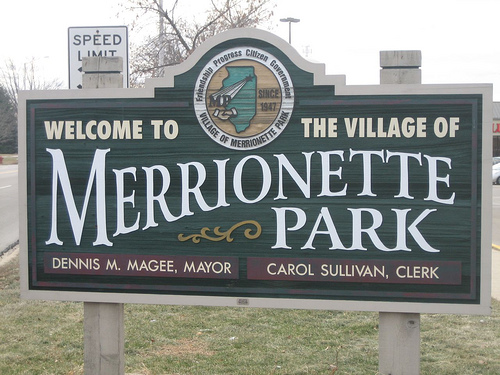
We begin our northbound walk back into Mount Greenwood at 10:20 am as the sky grows overcast. This blue-collar, Catholic community, a knob of the city surrounded by seven different cemeteries, produces more than its fair share of cops and firefighters. Here Kedzie is a manageable four-lane road lined with bungalows. The lawn of one of these at 11123 South has two-foot-tall wooden cutouts of a cherubic marine, sailor and soldier next to a yellow "Support Our Troops" ribbon.

We pass two beloved local eateries, Grant's Wonderburger, 11045 South, and Lindy's Chili and Ice Cream, 11009 South, then the Mount Greenwood Church of the Nazarene, 10454 South, with a sign in English and Arabic. Chicagoland Fitness and Schwinn, 10359 South, is the city's southwestern-most bike shop.
At 103rd, Kedzie leaves the city for Evergreen Park, the village that produced George Wendt (Norm from the sitcom "Cheers") and Ted Kaczynski, AKA the Unabomber. There are few traffic lights here and the ensuing high-speed traffic here reminds us that we're in the 'burbs. We detour west a couple blocks on 97th to check out a small, diamond-shaped park at the crossroads of eight streets.
Next we visit Snackville Junction, 9144 S. Kedzie, a diner where the plates are delivered by model train cars that ride a track around the oval-shaped counter. I buy some coffee to go, setting the cup on top of a gumball machine. When it slips and crashes to the floor, I yell the F-word in the restaurant full of small children and their parents. "Pardon my French," I say sheepishly.
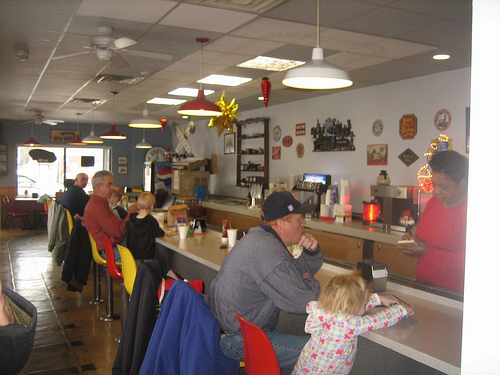
Guardian Auto Rebuilders, 8939 South, is topped by a large fiberglass Paul Bunyan look-alike whose hands were designed to hold either a muffler or an axe but are empty instead. After we pass Smokey the Bear Tobacco Shop, 8701 South, we're back in Chicago and the cars slow to a more pleasant speed for us adjacent pedestrians.

This is the Ashburn neighborhood, so named because it used to be a dumping ground for the city's burnt coals. "It's kinda funny," says Richard, "We haven't passed a single bar yet." As if in response, an anonymous Old Style bar soon appears at 8406 South, next to the Gaelic Fire Brigade, a private social club, but we decide it's too early to drink.
For the next few blocks most folks on the street are African-American. As we stare at the broken-down, atomic-age sign for Royal Cleaners, 8220 South, an elderly Jamaican lady comes out of the jerked chicken stand next door. "Are you interested in buying my building?" she asks. She's wearing a blue knit beret and a red apron that reads "Sexy Senior Citizen."
We pass 18th Ward Alderman Lona Lane's office at 8146 South, pass under a Metra viaduct and find ourselves at Don's Hotdogs, 7748 South. The fiberglass wiener on the roof is squirting mustard and, breaking the local taboo, ketchup on himself. He's wearing Chuck Taylors and tube socks and an American flag cape.
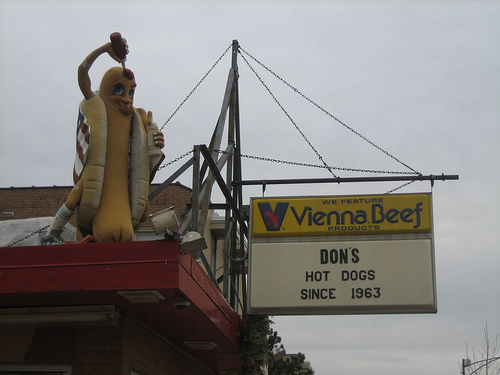
Here, Kedzie climbs over some railroad tracks, and we spy the Kraft Chicago Bakery, 7300 South which still has large NABISCO signage. Richard, an architecture buff, admires what he calls the Art Moderne streamlining of the building's window bays: "I love this stuff."
We descend into Marquette Park, the largest park on the Southwest Side, its lagoons frozen solid. North of the park in the Chicago Lawn neighborhood, many of the businesses have signs in Spanish. On a whim we stop for a drink on 66th Street at a salsa club called Ruta ("Route") 66. Richard addresses the barmaid in fluent Spanish, and she doesn't seem to understand when I order in English, so I figure it wouldn't be rude to hack my way through the conversation en español as well.

As we drink Coronas with lime and salt while salsa blares in the nearly empty bar, Melissa tells us she moved here from Nicaragua a few years ago. "Do you like Chicago?" I ask. "No," she says. "It's too cold here." "But Chicago is a very interesting city with many things to do," I protest in stilted Spanish. A bartender himself, Richard orders us a chelada, basically a Bloody Mary with beer instead of vodka, and grills Melissa about her other drink recipes before we move on.
At 64th, a mural on the Southwest Side Youth Collaborative building features Chinese dragons and carp, Mayan-inspired artwork, "Wildstyle" graffiti writing and Arabic calligraphy. We're starting to get hungry again, just in time for Richard to take me on tour of local Mexican restaurants that serve regional specialties.
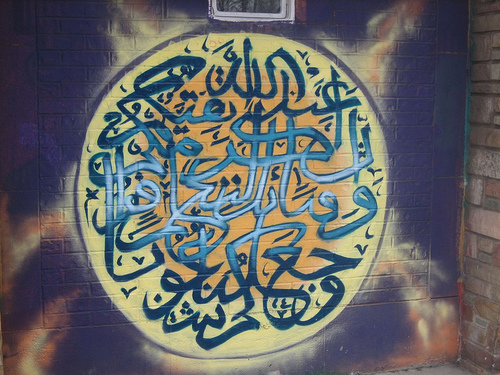
We start at La Chaparrita #2, 5958 South, for Veracruz-style tamales, wrapped in banana leaves. They're out of these so we buy miniature tacos filled with steak, steamed beef and cow head and scarf them down as we walk.
We pass the old Colony Theater and Betty's Ice Cream ("Good ice cream for good people") at 55th and decide to stop for a second beer at Ted's Firewater Saloon, 5834 South, which Richard says is run by three crazy old Irish sisters. The dive is decorated with stuffed deer and wild boar heads and the crowd is a mix of Anglos and Latinos.
After downing mugs of Old Styles with ice crystals floating in them, we head up the street to Rosa's Tamales, 5632 South, for atole, a warm, cornmeal-based drink. Richard orders me a guava-flavored atole and gets himself the chocolate version, called champurrado; I pick up some chicken tamales as well.
At 55th we pass St. Gall Catholic Church with its towering, minimalist cross and sweeping concrete buttresses, then see Kedzie Liquors across the street, its sign flanked by silver naked ladies. Next Richard takes me to Café-Chocolate, 5141 South, an ice cream parlor with that also serves savory specialties from the Mexican state of Durango, but only on weekends.
We get their versions of gorditas and burritos, made with homemade corn and wheat tortillas, respectively, and filled with carne deshebrehada (pulled beef), machaca (dried beef), rajas con queso (sweet peppers and cheese) or chile pasada (dried and stewed chile). The waitress also insists on us giving a few tangerines from a bowl on the counter.

By now I'm pretty stuffed, which is good because Richard warns me there won't be anything to eat for a few miles. Kedzie soon becomes dominated by strip malls and big box stores. At 45th we pass the Columbia Explorers Academy, named in honor of the ill-fated space shuttle mission.
As darkness falls we stop at La Acambarense Bakery, 3815 South, to pick up pan de Acambaro, a specialty from the state of Guanajuato, round loaves of sweet bread with raisins, marbled pink with food coloring. After passing under the Stevenson Expressway we cross the Sanitary and Ship Canal and enter the Little Village neighborhood.
The Washburn Technical School used to exist at 31st. Richard says one of the school buildings, "a beautiful, creamy-white Art Moderne," has already been demolished. The other structure, a hulking red brick building with many broken windows, covered in graffiti, seems destined for the wrecking ball.
By the railroad tracks near 28th there are more murals with vivid Pre-Columbian and Chinese imagery, as well a cartoonish exploding skull. The smell of fresh tortillas grows strong as we approach the vibrant 26th Street Mexican business district.
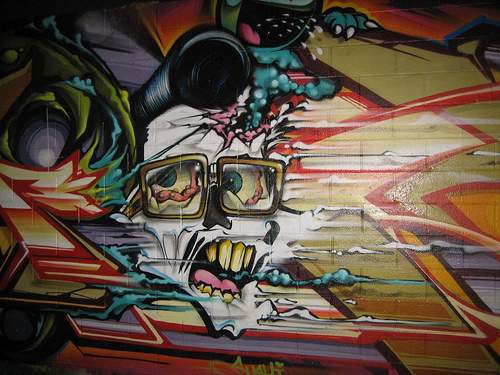
Richard suggests we head a bit east to Aguascalientes supermarket, next to the archway over 26th that says "Bienvenidos a Little Village," to sample another style of gordita. These are made with thick rounds of grilled homemade corn dough. I get one stuffed with pork loin in red adobo sauce, beans and cheese - absolutely delicious.
Mi Tierra, 2528 South, is a massive restaurant with pink adobe walls and a bell tower, while across the street Volkan nightclub draws 20-somethings to dance to Latin music and disco. Botanica El Secreto Azteca, 2413 S. sells spiritual goods, including many statuettes of saints with skulls for faces. Richard tells me these are bought by followers of the Santo Muerte ("Dead Saint") cult which is gaining ground in Mexico, to the dismay of the Catholic Church.
Cermak Avenue, 2200 South, is the sharp dividing line between Mexican-American Little Village with its healthy retail strips and Lawndale, an underserved African-American community with many shuttered businesses, vacant lots and burned-out buildings.
Richard is up for walking through the night, but I chicken out, remembering that a few blocks up the street is a stretch of Kedzie with broken streetlights. I've been hassled while bicycling through that section in the dark, so I decide it's best to continue the walk in daylight. We shake hands and Richard catches the Cermak bus east to the Red Line while I ride the California-Kedzie north back home to Garfield Park.
That Monday morning at 8:30 I meet up with Casey, who recently taught English in Patagonia with my girlfriend, at the Kedzie Pink Line station near Cermak and we resume the walk. He moved to Chicago just three days earlier, so I figure this a chance to show him the city's cultural diversity.
Just north of the station, the skull-and-iron-cross logo painted on the window board-up at 2101 S. suggests it's the headquarters for an outlaw biker gang, but the buzzer says Illinois Manufacturing Co. A few blocks later, a mural on the side of cellular store at 1556 S. features a folk-art image of Halle Berry as Catwoman -- her feline predecessor Eartha Kitt died this Christmas Day.
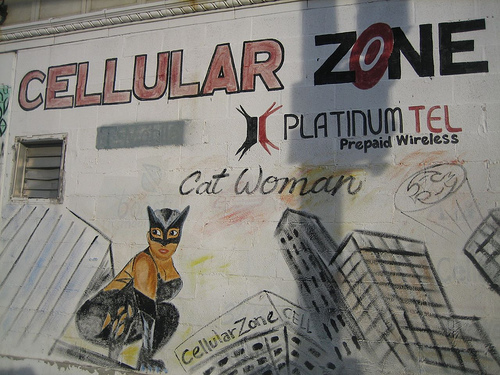
Douglas Boulevard, 1400 South, is part of the Boulevard System of Chicago which links most of the city's major parks with broad roadways with grassy medians running down the middle. A weathered sculpture of a monolithic mother, father and child sits in the middle of Douglas.
I snap a picture of a beat-up sign for live catfish outside a grocery store at 1253 South, and as we walk away Casey say he thinks some guys are breaking into a car in the parking lot. "Maybe we should make a citizen's arrest," I reply.
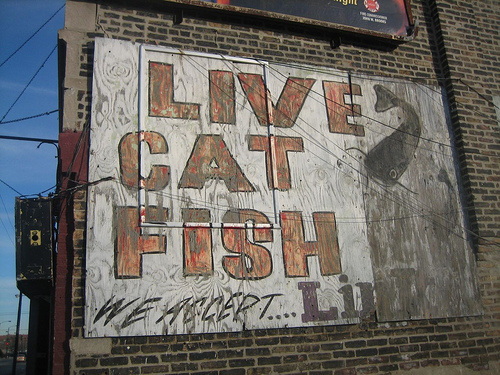
After we cross the Eisenhower Expressway back into Garfield Park, we see a large mural at the Kut Zone, 407 S. featuring a bling-laden barber giving a customer a fade. A few blocks later we come to Edna's, 3175 W. Madison, a cozy soul food place where Martin Luther King Jr. hung out while campaigning for fair housing in Chicago. A few years ago I ate there with a friend who's Filipina. As we entered the restaurant, a small boy behind us on the sidewalk called out, "Hey, white lady." She was pissed.
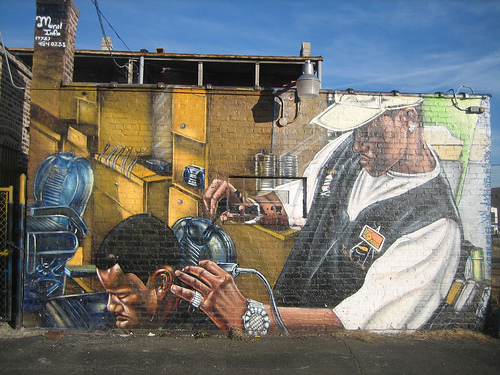
Just north of the Green Line stop at 259 North, a hand-painted sign on a telephone pole says, encouragingly, "We are all good people." We're only two blocks from my apartment but we keep walking, past the old factory building where my friend Steve lives. One of his neighbors is G the Sign Painter, an elderly Native American man who lives in his workshop and claims to have fathered 60 children.
I've been meaning to visit the 007 Lounge, 600 North, but it's only 9:30 am when we pass by. My landlord won't go to the bar with me for fear of getting shot, but Steve has told me the place is all right. "I went there early one time and the owner was really cool =- he's a funny guy," he said. "The pimps and hookers and drug dealers started showing up later on."
A couple blocks later, a tall young man with a rhinestone-studded leather jacket approaches us. I'm guessing he's going to ask us for money but instead he strikes up a conversation about the History Channel. "Did you guys see that show about Nostradamus?" he asks. "It's called 'Countdown to Armageddon.' It's real nice."
Soon Casey and I enter Humboldt Park, the city's Puerto Rican neighborhood, and around 1400 North we enter the eponymous park and climb a man-made hill for an unusual view of the skyline. At Armitage, 2000 North, we come to the "ghost bike" memorial for Blanca Ocasio, who was killed on her bicycle at this intersection in September 2007 when a garbage truck hit her. Six months later Amanda Annis died on her bike at the same spot after a car ran a red.
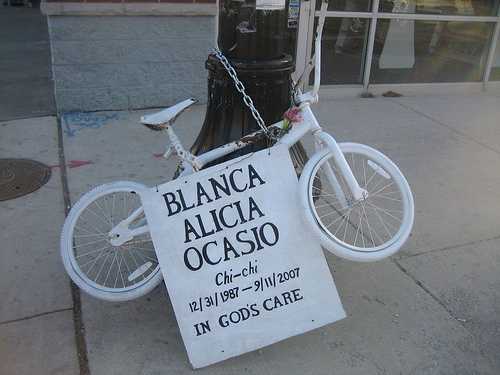
Kedzie becomes a broad boulevard at Palmer Square Park, 2200 North, as we approach the eagle-topped pillar of the Illinois Centennial Monument, the center of the gentrifying Logan Square neighborhood. We pass by the bike shop where I work, Boulevard Bikes, 2535 North, but it's closed on Mondays, so we keep moving, negotiating the tricky six-way intersection and traffic circle around the nearby monument.
We enter Avondale, a heavily Polish community, pass under the Kennedy Expressway and then see a number of frozen pigeons under a Metra viaduct. Casey wonders if someone poisoned them.
Soon we're multi-ethnic Albany Park. D'Candela Peruvian Restaurant, 4053 N., offers roast chicken and other hearty dishes like Lomo Saltado (beef slices sautéed onions and tomatoes_, served with rice and fries. Arun's, 4156 North, is a fancy Thai restaurant where I once ate an exquisite eight-course meal for my birthday. We soon enter a stretch with many Arab-owned businesses, and stop at Sanabel Bakery, 4253 North, to pick up some spinach and cheese pies.
Casey suggests we visit Our Lady of Mercy, 4331 North, a Roman Catholic church with twin steeples and a domed cupola. We yank on the locked doors and are about to walk away when a friendly, white-robed priest lets us in. Built in 1953, the church's sanctuary feels modern but it has a lovely traditional altar with black marble columns and a huge crèche scene set up in front for the holidays. A drum kit and microphone stands are set up nearby and a sign says in Spanish and English, "No food, no gum, turn off cell phone."
I buy some Middle Eastern pastries made with filo dough, honey at pistachios at Feyrous Bakery, 4510 N., and we stop into a McDonalds to take advantage of Free Latte Monday and eat the sweets. Continuing, we pass stores selling hookahs, cookware and wall hangings with Arabic calligraphy embossed in metal.
Around 4600 North, a Brown Line train rumbles by at street level and we pass Noon-O-Kabob, my favorite Iranian restaurant. I've been told Andy's Fruit Ranch, 4733 North, sells every form of produce known to man.
After Lawrence, 4800 North, we start seeing signs in Korean and soon we cross the North Branch of the Chicago River. The Center for Seniors, 5320 North, has a pleasant Asian garden on its grounds with stone lanterns and topiaried trees that look like something out of Dr. Seuss. A few blocks of Bryn Mawr, 5600 North, west of Kedzie contain mostly Korean businesses. This strip is blocked off each summer for one the city's best street festivals; one intersection is filled with sand for sumo-like wrestling bouts.
At this point the north-south street temporarily changes names from Kedzie to Jersey and angles northwest slightly, paralleling the North Shore Channel. The channel meets up with the Chicago River a few blocks south, forming a miniature waterfall.
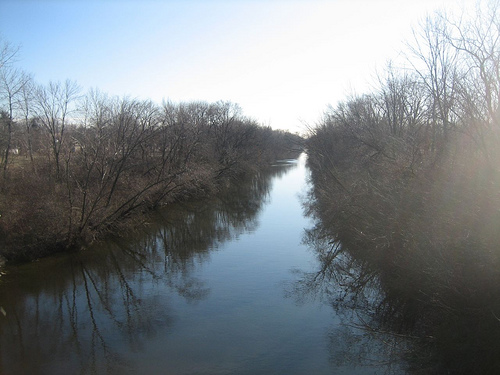
We're approaching Rogers Park, the center of Chicago's Orthodox Jewish community, and as we pass Congregation Beth Shalom Ahavas Achim, 5655 North, an unmarked police car pulls up alongside us. An officer in a bulletproof vest and stocking cap requests our ID and asks us where we live before letting us go. "What's going on?" I ask. "We're looking for someone right around here," the cop replies.
Casey stops for another free McDonalds latte at Peterson, 6000 N., before we head east to where Kedzie resumes as a quiet residential street on the other side of the channel. I'd promised Casorthy we'd get lunch on Devon Street, 6400 North, which is famous for its many blocks of Indian and Pakistani businesses. So we detour several blocks east, past Russian, Georgian, Assyrian (a Christian ethnic group from the Middle East) and Jewish businesses to my favorite Indian buffet joint, Sher-A-Punjab, 2510 W. Devon.
But when I return to the table with a full plate of curries, Casey tells me he's going to skip lunch - all those lattes did a number on his stomach. He decides to head back downtown, but first we toast our walk with cans of PBR at his namesake dive bar, Casey's Corner, down the street at 2733 W. Devon.
After I put him on a bus, I return to Kedzie and the giant baseball at Thillens Little League Stadium, 3200 W. Devon. The last 12 blocks of my trek are pretty monotonous. To my left is the wooded east bank of the channel, eventually obscured by an industrial zone. To my right are boring suburban-style residences, followed by four matching, monolithic senior high-rises, the Winston Towers.
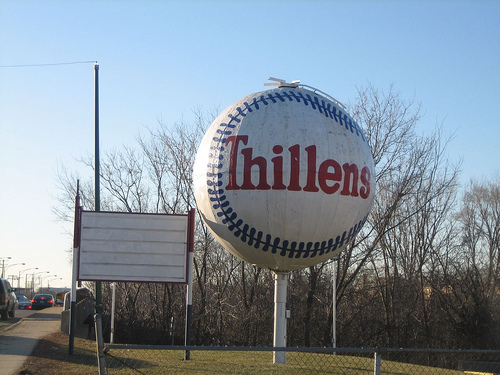
Finally, with stiff knees and sore feet, I reach the terminus of Kedzie at Howard Street, 7600 North, the Evanston border. A Jewel-Osco, Best Buy and other big boxes loom in front of me. It's a dull ending to a fascinating walk.
About the Author
John Greenfield has spent his entire adult life in Chicago. He enjoys writing, biking and rocking.









johnny_socko / January 27, 2009 12:15 PM
I enjoyed reading about your trek. I grew up in Rogers Park and your mention of Thillens brought back memories of being a kid playing softball there in the early 80s.